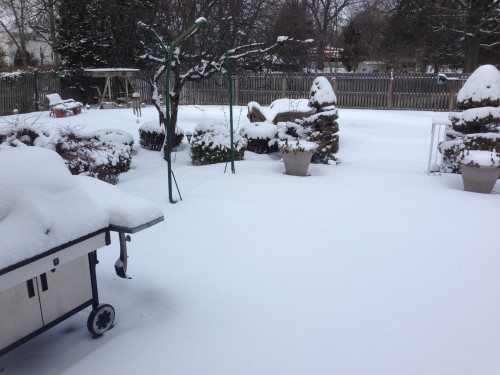This week, those of us in the Northeast Corridor were promised an “historic” winter storm, with measurements of two, three, or more feet, throughout New Jersey and the New York City area. Well, it didn’t quite get that bad, as our amount of snowfall was closer to four inches.
Four inches? ex ante risk
And it looks like other areas that were to have received the brunt of the storm didn’t get anything close to what was threatened. And here I thought that I’d be witnessing history in the making!
And so, what went wrong? The Wall Street Journal suggests it has to do with models (“Weather Experts Trusted the Model That Had Served Better at Predicting Superstorm Sandy”). An old model was used to predict what would occur, rather than a newer one; the old predicted Armageddon, while the newer said it would be much less snow falling upon us. Apparently they should have mentioned to us that there was at least one other possible outcome, but they seemed quite adamant that we were going to have an historic storm of epic dimensions. Oh, well…
What can we learn? ex ante risk measurement
Isn’t there a saying, “you can’t predict the weather”? Well, we have people predicting it all the time, and they’re no doubt getting much better at it. In fact, we rely heavily upon these predictions and tune in regularly for the latest. But this forecast of a “long tail event” missed the mark. Isn’t this reminiscent of Nassim Taleb’s The Black Swan? He takes aim at those who attempt to tell us the future.
There’s definitely a movement afoot in our industry for ex ante risk measurement; that is, forward looking risk. This is done using a variety of, yes, models, that typically take into consideration the recent past, with the expectation that the past can be used to predict the future (which, for returns, is completely improper, but for risk is allowable).
While I’m not a huge fan of ex ante risk measurement, I recognize that it’s important for investors to have a sense of what the risk is over the next day, week, month, year. But we need to know that these models, like the storm predicting variety, are not perfect. While they may offer some value, it’s limited. We must take into consideration their assumptions and the likelihood of their predictions coming true. And, we should test them from time to time to ensure they’re at least “in the ball park.”
As for the storm, don’t get me wrong: I’m much happier with just four inches of the white stuff.
p.s., please review this video to gain more on this subject.

